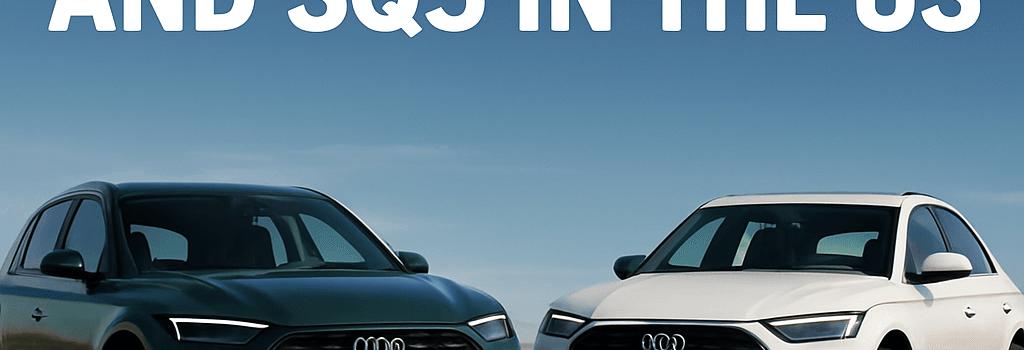Audi Launches Third-Gen Q5 and SQ5 in the US

ASPEN, Colo. – Audi’s third-generation Q5 and its performance-oriented sibling, the SQ5, have landed stateside with an all-new platform, cutting-edge software architecture, and refined driving dynamics. Following our studio preview last year, this hands-on drive on Colorado’s roads reveals how Audi’s latest midsize SUVs combine traditional combustion powertrains with a “software-defined vehicle” (SDV) ethos.
1. Under the Hood: Powertrain Deep Dive
At launch, US buyers can choose between two turbocharged engines, both mated to a seven-speed dual-clutch transmission (DCT) and quattro all-wheel drive:
- Q5: 2.0 L TFSI inline-4, 268 hp (200 kW) @ 5,000 rpm, 295 lb-ft (400 Nm) @ 1,600–4,500 rpm, 0–60 mph in 5.8 s.
- SQ5: 3.0 L TFSI V6, 362 hp (270 kW) @ 5,000–6,400 rpm, 406 lb-ft (550 Nm) @ 1,370–4,500 rpm, 0–60 mph in 4.9 s.
Audi’s Premium Platform Combustion (PPC) underpins both variants. PPC represents VW Group’s dedicated combustion architecture, optimized for weight reduction and packaging flexibility. Advanced cast-aluminum subframes, high-strength steels, and targeted use of CFRP (carbon fiber reinforced polymer) in body panels reduce mass by up to 50 lb versus its predecessor.
2. Software-Defined Vehicle Architecture
Moving beyond traditional CAN bus systems, the Q5/SQ5 employ VW Group’s E3 1.2 SDV architecture. Key features include:
- High-Performance Domain Controllers: Five zonal computers manage infotainment, ADAS, powertrain control, vehicle dynamics, and body/climate functions over a 1 Gbps Ethernet backbone.
- OTA Update System: Secure in-house V2X and telematics units enable incremental firmware updates for all domains.
- Android Automotive OS Integration: The new MMI uses AAOS, offering native apps, Google Assistant, and real-time over-the-air map updates.
“The transition to a software-centric network allows us to push new features faster and simplify hardware maintenance,” explains Dr. Markus Hintermeier, Head of Audi Electronics Development.
3. In-Car Experience and HMI Enhancements
The dual-screen “Digital Stage” comprises a 10.1″ central touchscreen and an optional 8.6″ passenger display. Audi’s voice assistant, triggered by “Hey, Audi,” uses on-device natural language processing, reducing latency to under 200 ms for common commands.
- Virtual Cockpit Plus: 12.3″ configurable cluster with 60 fps graphics, now supports 3D nav overlays.
- Capacitive Touch Controls: Steering wheel panels for volume and menu scrolling – though some users report unintended activations.
- Acoustic Laminated Glass: Standard at Prestige trim, cuts cabin NVH by up to 5 dB.
4. Driving Dynamics and Suspension
Both models offer multi-chamber air suspension with dynamic damping control. Drive modes include Comfort, Balanced, Dynamic, Individual, Off-road, and Off-road Plus, each adjusting:
- Spring stiffness (up to 35% firmer in Dynamic)
- Steering weight (up to 30% heavier for precision)
- Throttle mapping and shift logic
On Colorado’s mountain passes, the Q5’s balanced mode delivered a refined blend of body control and ride comfort, while the SQ5’s sharper calibration and rear sport differential maintained poise under heavy braking and cornering.
5. Advanced Driver Assistance Systems (ADAS)
Building on Audi’s pre-sense suite, the new Q5 adds:
- Highway Assist 3.0: Combines adaptive cruise, lane centering, and traffic-jam pilot for Level 2 hands-on driving.
- Intersection Assist: Radar and stereo-camera fusion prevent crossing collisions at speeds up to 37 mph.
- Remote Park Pilot: Smartphone-controlled autonomous parking and retrieval in tight spaces.
6. Over-the-Air Updates and Cybersecurity
Audi’s secure gateway ECU employs hardware-backed encryption and ISO 21434–compliant firewalling. Firmware is signed using PKI, ensuring authenticity. Recent OTA packs have introduced:
- Enhanced night-vision thermal imaging (via optional camera upgrade)
- Updated acoustic pedestrian alert sounds for EU models, adaptable for US regulations
- UI refinements in MMI and Virtual Cockpit
“Our cybersecurity team conducts continuous vulnerability assessments, leveraging intrusion detection systems on the CAN/Ethernet hybrid bus,” says cybersecurity lead Ana Martinez.
7. Platform Scalability and Future EV Integration
Although the Q5 and Q6 e-tron sit on different physical platforms, E3 1.2’s domain-based software stack is shared. This enables:
- Modular Feature Deployment: New xEV models can adopt the same ADAS and infotainment modules with minimal re-engineering.
- Rivian Collaboration: Following VW Group’s $5B investment, select EV software components (battery management, thermal controls) will migrate from Rivian’s ED4 platform for the upcoming Q5 e-tron.
8. Pricing, Trims, and Equipment
The Q5 starts at $52,299; the SQ5 at $64,800. Key option packages include:
- Premium Plus: Heads-up display, USB-C charging (2×60 W front, 2×100 W rear), Park Assist – $4,500 (Q5), $3,500 (SQ5).
- Prestige: Air suspension, acoustic glass, Nappa leather, passenger display – $8,400 (Q5), $6,400 (SQ5).
Plug-in hybrid Q5 and mild-hybrid 48 V variants remain Europe-only for now, while the pure-electric Q6 e-tron fills the zero-emission gap in Audi’s midsize lineup.
Conclusion
Audi’s third-gen Q5 and SQ5 bring a compelling mix of combustion efficiency, dynamic performance, and software sophistication to the US market. With its SDV foundation, scalable platform, and robust OTA ecosystem, the Q5 range signals Audi’s evolution toward a connected, software-driven future.